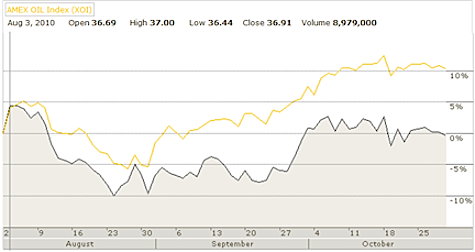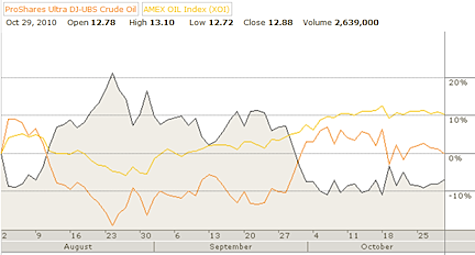Is oil on the out? With oil spill accidents rocking the news channels lately, it may be so. But it’s something you can study and affirm from investment behavior in this sector. I consider commodity investing as a bit outside of the realm of small investors (such as myself), but I remain fascinated by how the investment world works. I’m trying my hand at investigating these rather more esoteric investments and laying it out there. We present this as a way to explore something new, without necessarily taking the “expert stance”. If you have some thoughts, tips and ideas on investing in the oil or commodity sector, let us know!
Before we talk about a few of the oil ETFs (exchange traded funds) on the market, I would be remiss if I didn’t give you a few words of warning. It was only a few years ago when the price of gas topped $4 per gallon. All of us were wondering how the price of oil could possibly go up that fast and that dramatically. Not only were we all hating a trip to the gas station, but everything in our lives that used oil as fuel (most everything) went up dramatically.
Later, once oil prices stabilized, we found out that oil didn’t rise on true market fundamentals but instead, did so because oil speculators drove the price up. Speculators are still alive and well in the commodities market and for anybody trying to play oil on market fundamentals, there are variables that are both hard to control and hard to forecast.

Along with speculators, other factors such as natural events like hurricanes, geopolitical concerns, OPEC production levels, and so forth, affect oil prices — and that’s aside from this factor called “contango” (longer term oil contracts are priced higher than near term ones), which is beyond the scope of this post.
The point is this: understand that playing oil and many other commodities is done successfully by professional traders and those who commit themselves to playing the commodity market. Be very careful and practice good hedging. So are there ways for average investors to invest in commodities?
How To Invest In Oil ETFs: Some Facts
Now that I’ve warned you, let me tell you that in a diversified portfolio, playing oil technically (by using a chart study) can yield reasonable results when using a quasi swing trading strategy. Big words, I know, but when oil is at the top of its range, take a short position. When it’s nearing support levels on the charts, consider a long position. Pure and simple, this is market trading. So unless you’re dedicated to the activity, it’s something to be wary of.
If you want to play oil through ETFs, understand that most oil and gas ETFs track the price of futures contracts. Unlike gold ETFs and other commodity funds, it’s not practical for these funds to hold oil or gas. It would cost far too much money to rent tankers and storage facilities. This is a variable in itself because futures contracts don’t always behave as they should.
Before we look at oil ETFs to consider, let’s look at the index we’re going to use for comparison purposes. When we’re talking about stock performance, we look at the S&P 500 or the Dow Jones Industrial Average. When we want to compare a single oil stock or ETF to an index, we can certainly compare them to the S&P 500; however, it would be much more accurate to compare it against the XOI, which is a basket of leading companies in all facets of the oil market. Comparing to the oil futures is difficult because of the varying prices from month to month.
Now that you have the background, let’s look at some oil plays:
United States Oil Fund, LP USO
The USO is probably the most popular oil ETF in the marketplace. It’s a pure play on oil that tracks the performance of the spot price of West Texas Intermediate light, sweet crude oil delivered to Cushing, Oklahoma. This is a lot of jargon that describes a fund that tracks the price of crude oil through futures contracts. If all you are looking for is a way to play the price of oil, then this may be one of your best options (although I’m not making any buy or sell recommendations).
Let’s look at a 2010 chart, though, and see if this has been a high performing way to play oil:

The bottom, grey line is the USO chart and the top is the oil index, XOI. As we can see, the USO is flat where XOI is up 10%. Quite a dramatic difference. In this case, for the period ending October 29, 2010, USO has not been a good way to play oil. Don’t forget that ETFs have management and rebalancing fees associated with them!
ProShares UltraShort DJ-UBS Crude Oil SCO
Here’s a short play. If you believe the price of oil is heading south, then take a look at SCO. This is an inverse ETF where you make money when the price of oil goes down. In fact, with this fund, when the price of oil drops by 1%, you make 2% (minus fees) thereby making this a leveraged inverse ETF. This is a mouthful, but you can find out more about leveraged ETF investing here.
The SCO doesn’t directly track the price of oil futures. Instead, it tracks another oil index, Dow Jones – AIG Crude Oil Sub-Index which tracks crude oil futures. To be painfully simple, SCO tracks an index that tracks oil futures so this ETF simply adds one more confusing layer to the mix. (By the way, if you want an ETF that isn’t an inverse fund but that does the same thing, then buy the SCO’s big brother, UCO)
Let’s take a look at the chart to see how the SCO fares against our index, the XOI:

What we have here is our index plus the SCO in grey and the UCO in orange. Do we still like the XOI over pure oil plays? Yes, showing a chart of a short ETF shouldn’t change our premise since our first two ETFs are correlated to the same thing.
Energy Select Sector SPDR Fund XLE
The XLE is not a pure oil play but it’s pretty close. In fact, 93% of this fund is made up of companies in the oil and gas sector. This is not a fund that tracks the performance of oil futures. Instead, much like the XOI index, the XLE tracks the performance of companies in the business of oil and gas. Some of the larger companies include Exxon, Conoco Phillips, Haliburton, and Devon Energy. How does the XLE measure up to our index?

The yellow line is the XOI index, and the grey is the XLE. As you can see, it has almost perfect correlation but this is largely due to the fact that they track the same companies.
Of course you can also play oil by playing the various companies. In fact, this may be the more desirable way since other variables that you can account for will affect the stock’s price along with oil prices. You can research past earnings, CEO performance, and how the company reacts to changing oil prices. Some will have strong correlation to the price of oil while others will be less affected.
There you have it. A little bit confusing? Certainly. This is why if you ask my opinion, I would tell you to steer clear of the oil sector. There are other areas of the market that are much more favorable to the part time investor.
Disclosure: I have a long position in Marathon (MRO) along with covered calls sold against the position as both a hedge and an additional revenue stream.
Copyright © 2010 The Digerati Life. All Rights Reserved.

{ 4 comments… read them below or add one }
These ETFs that attempt to track the price of commodities through futures contracts typically do a poor job of it. I’d stay away from them and stick with the physical metals commodity ETFs or buy natural resource stocks.
If something gets too complex it’s always a sure signal for any investor to be wary of the investment. Trouble happens when there’s a disconnect between what the investment stands for and what investors believe they’ll make by putting their money in it. Case in point: mortgage backed securities. If people made the effort to understand an investment and its underlying components, they may think twice before getting involved. But lots of people love to chase market movement regardless of what it is that’s behind it. It’s the nature of investment markets (and investment psychology). That’s why I enjoy looking into articles like this — some exposure to what’s out there could give us some pause.
Diversification can go too far. I believe that there are certain investments out there that you may want to think twice before entering, even if you are keen on diversifying your asset base. If you want to go into commodities, you may want to settle on precious metals representation.
I treat Oil as a purely speculative play, but I have done so using USO several times over the past years.
Over the very long run, I think oil prices can only go up as it becomes more scarce and more expensive to extract.